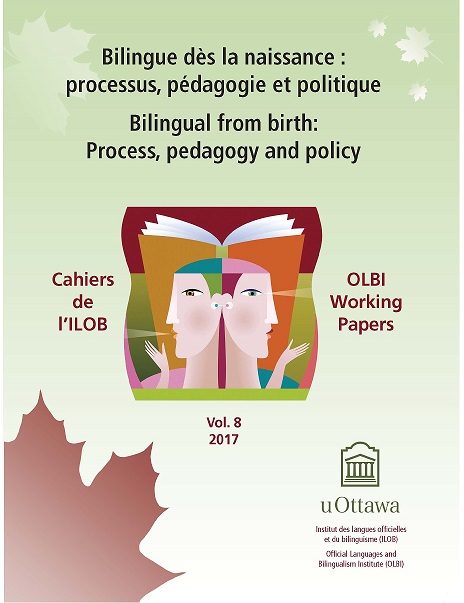Accepting labels in two languages: Relationships with exposure and language awareness
DOI :
https://doi.org/10.18192/olbiwp.v8i0.2115Mots-clés :
bilinguisme, enfants, âge préscolaire, développement langagier, nouveaux termesRésumé
Dans une étude portant sur les effets de l’exposition à une langue seconde sur l’acquisition du vocabulaire, des enfants anglophones ont entendu de nouveaux termes produits par des locuteurs d’anglais et d’espagnol. Les enfants ont été classés en fonction de leur niveau d’exposition à l’espagnol et de leur maîtrise de cette langue en trois catégories : enfants à exposition minimale, enfants à exposition modérée et enfants bilingues. Les enfants à exposition modérée ont accepté les termes des deux groupes de locuteurs plus fréquemment que les enfants à exposition minimale, et étaient statistiquement équivalents aux bilingues. Le niveau de sensibilisation à la langue a aussi été évalué chez les enfants. Il était associé à leur volonté d’accepter les termes dans les deux langues ainsi qu’à leur degré d’exposition à l’espagnol.
Références
Akhtar, N., Mejivar, J.A., Hoicka, E., & Sabbagh, M.A. (2012). Learning foreign labels from a foreign speaker: The role of (limited) exposure to a second language. Journal of Child Language, 39, 1135–1149. doi:10.1017/S0305000911000481
Au, T.K., & Glusman, M. (1990). The principle of mutual exclusivity in word learning: To honor or not to honor? Child Development, 61, 1474–1490. doi:10.1111/j.1467-8624.1990.tb02876.x
Bialystok, E. (1988). Levels of bilingualism and levels of linguistic awareness. Developmental Psychology, 24, 560–567. doi:10.1037/0012-1649.24.4.560
Bialystok, E. (1999). Cognitive complexity and attentional control in the bilingual mind. Child Development, 70(3), 636–644. doi:10.1111/1467-8624.00046
Bialystok, E. (2001). Bilingualism in development: Language, literacy, and cognition. New York: Cambridge University Press.
Bialystok, E., & Feng, X. (2009). Language proficiency and executive control in proactive interference: Evidence from monolingual and bilingual children and adults. Brain and Language, 109, 93–100. doi:10.1016/j.bandl.2008.09.001
Bialystok, E., & Majumder, S. (1998). The relationship between bilingualism and the development of cognitive processes in problem solving. Applied Psycholinguistics, 19, 69–85. doi:10.1017/S0142716400010584
Cummins, J. (1978). Bilingualism and the development of metalinguistic awareness. Journal of Cross-Cultural Psychology, 9, 131–149. doi:10.1177/002202217892001
Davidson, D., & Tell, D. (2005). Monolingual and bilingual children’s use of mutual exclusivity in the naming of whole objects. Journal of Experimental Child Psychology, 92, 25–45. doi:10.1016/j.jecp.2005.03.007
Dunn, L.M., & Dunn, L.M. (1986). Test de Vocabulario Peabody. Circle Pines, MN: American Guidance Service.
Dunn, L.M., & Dunn, L.M. (1997). Peabody Picture Vocabulary-III. Circle Pines, MN: American Guidance Service.
Fernandez, M. (2006). Bilingual preschoolers: Implications for the development of identity and self-concept. Journal of Early Childhood and Infant Psychology, 2, 5–16.
Koenig, M., & Woodward, A. L. (2012). Toddlers learn words in a foreign language: The role of native vocabulary knowledge. Journal of Child Language, 39, 322–337. doi:10.1017/S0305000911000067
Krumm, H.J., & Jenkins E.M. (2001). Kinder und ihre Sprachen — lebendige Mehrsprachigkeit: Sprachenportraits [Children and their language — living multililingualism: Language portraits]. Vienna: Wiener VerlagsWerkstatt für Interkul- turelles Lernen und Deutsch als Fremdsprache [The Viennese Publishing Workshop for Intercultural Learning and German as a Foreign Language].
Martin, B. (2012). Coloured language: Identity perception of children in bilingual programmes. Language Awareness, 21, 33–56. doi:10.1080/09658416.2011.639888
Melo-Pfeifer, S. (2015). Multilingual awareness and heritage language education: Children’s multimodal representations of their multilingualism. Language Awareness, 24, 197–215. doi:10.1080/09658416.2015.1072208
Sá, M.H.A.E., & Melo, S. (2007). Online plurilingual interaction in the development of language awareness. Language Awareness, 16, 7–20. doi:10.2167/la356.0
Stewner-Manzanares, G. (1988). The Bilingual Education Act: Twenty years later. New Focus Series: Occasional Papers in Bilingual Education (1987–1989), no. 6. Silver Spring, MD: National Clearinghouse for Bilingual Education. Available at: ncela.ed.gov/files/rcd/BE021037/Fall88_6.pdf.
Téléchargements
Publié-e
Numéro
Rubrique
Licence
Les auteurs qui publient avec Les Cahiers de l'ILOB acceptent les termes suivants:
- Les auteurs conservent le droit d'auteur et accordent à la revue le droit de première publication, l'ouvrage étant alors disponible simultanément, sous la licence Licence d’attribution Creative Commons permettant à d'autres de partager l'ouvrage tout en en reconnaissant la paternité et la publication initiale dans cette revue.
- Les auteurs peuvent conclure des ententes contractuelles additionnelles et séparées pour la diffusion non exclusive de la version imprimée de l'ouvrage par la revue (par ex., le dépôt institutionnel ou la publication dans un livre), accompagné d'une mention reconnaissant sa publication initiale dans cette revue.
- Les auteurs ne soumettront pas simultanément le même travail pour publication à plus d’une revue spécialisée à la fois.


